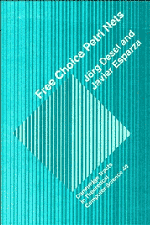Book contents
- Frontmatter
- Contents
- Preface
- 1 Introduction
- 2 Analysis techniques for Petri nets
- 3 S-systems and T-systems
- 4 Liveness in free-choice systems
- 5 The Coverability Theorems
- 6 The Rank Theorem
- 7 Reduction and synthesis
- 8 Home markings
- 9 Reachability and shortest sequences
- 10 Generalizations
- References
- Index
- List of symbols
- List of main results
3 - S-systems and T-systems
Published online by Cambridge University Press: 21 October 2009
- Frontmatter
- Contents
- Preface
- 1 Introduction
- 2 Analysis techniques for Petri nets
- 3 S-systems and T-systems
- 4 Liveness in free-choice systems
- 5 The Coverability Theorems
- 6 The Rank Theorem
- 7 Reduction and synthesis
- 8 Home markings
- 9 Reachability and shortest sequences
- 10 Generalizations
- References
- Index
- List of symbols
- List of main results
Summary
This chapter presents the main results of the theory of S-systems and T-systems. It is divided into two sections of similar structure, one for each of these two classes. The main results of each section are a Liveness Theorem, which characterizes liveness, a Boundedness Theorem, which characterizes b-boundedness of live systems, and a Reachability Theorem, which characterizes the set of reachable markings of live systems. Additionally, both sections contain a Shortest Sequence Theorem, which states that every reachable marking can be reached by an occurrence sequence whose length is bounded by a small polynomial in the number of transitions of the net (linear in the case of S-systems and quadratic for T-systems).
S-systems
Recall from the Introduction that S-systems are systems whose transitions have exactly one input place and one output place.
Definition 3.1S-nets, S-systems
A net is an S-net if |•t| = 1 = |t•| for every transition t.
A system (N, M0) is an S-system if N is an S-net.
The fundamental property of S-systems is that all reachable markings contain exactly the same number of tokens. In other words, the total number of tokens of the system remains invariant under the occurrence of transitions.
Proposition 3.2Fundamental property of S-systems
Let (N, M0) be an S-system. If M is a reachable marking, then M0(S) = M(S), where S is the set of places of N.
- Type
- Chapter
- Information
- Free Choice Petri Nets , pp. 41 - 62Publisher: Cambridge University PressPrint publication year: 1995



